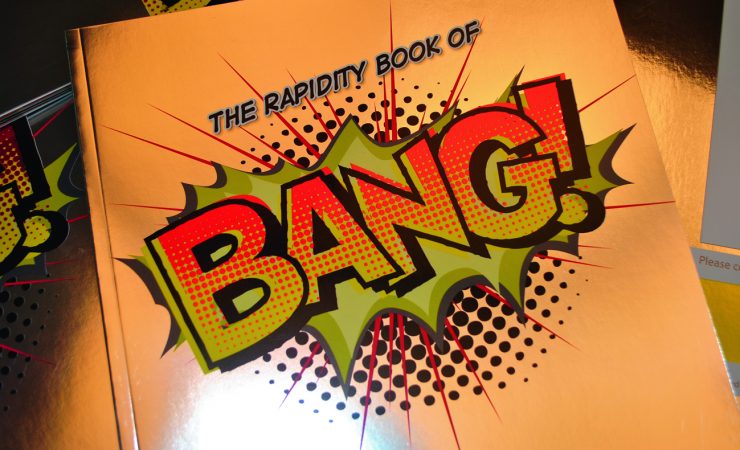Rapidity has produced this book to showcase its capabilities
Rapidity in London is exploring the possibilities of the range of special effects that are possible with the HP Indigo 7600 press.
There was once a famous BT advert starring Bob Hoskins from which the catchphrase – ‘it’s good to talk’ – was repeated throughout the land. Paul Manning seems like the kind of man who would agree with the sentiment, and when he speaks to his customers these days, he really does have something to talk about.
His company, London-based Rapidity, is one of the few print companies in the UK making use of a range of special effects that can be created on the HP Indigo 7600 press, of which the company has two.
Embossedstyle textured effects, raised print using layers of transparent ink applied directly to the substrate, digital watermarks (again using transparent ink), and HP Indigo’s ElectroInk White, which allows printing on a diverse range of media, including transparencies, dark and metallic substrates; these all add up to one thing: creative, high value applications that most print providers simply cannot provide in short runs or with personalisation.
‘We’re aiming for difference,’ he told Digital Printer. ‘It’s not good enough to just put four colours down on a sheet. The Indigo 7600 gives us something to talk to our clients about.
Before, we were talking to people about location, service, turnaround…but lots of people talk about that. We decided that if we were going to be in central London and compete, then we needed to go for agencies and give them something that adds value.
‘We will be going up against someone with a four colour engine and saying, yes we can do that but not only is our quality better, but we have a second gear to go to.’
He does not feel that the company has exploited the special effects yet, but then the presses only arrived in April 2013. It also takes some time for the message about these creative possibilities to percolate down in the minds of the designers and agencies that Rapidity is talking to. A specially produced book called ‘Bang!’ is being used by Rapidity to market the capabilities of the Indigo presses. ‘We are being forced to sell and market this properly. That’s something that the print industry struggles with,’ he said. Of the various effects possible, the white and clear inks have got him especially excited.
He continued: ‘These have got the potential to work for people in ways not envisaged before. We can print straight onto black substrate with white ink; or clear ink to mimic a spot UV. We can produce a non-laminated, non-foiled printed product that is environmentally friendly, and we can do small quantities. So this really could work.’
There is more to it than just the inks though. ‘The special effects on their own are really good, but with speciality media they really come into their own, using things like Mirri board to create ‘foils’; and all the special effects can be personalised, apart from the raised print, which requires a mould.’
Rapidity has been working on creating its own metallic board, much like another HP Indigo user, Falkland Press in Hatfield. Mr Manning voices the opinion that ‘there’s probably not a paper company out there that’s not developing its own silver stock now’.
Companies such as Antalis, Mohawk and GF Smith have all been working hard on digital stocks, he said. ‘The paper companies seem to be really interested in creating a decent market for it.
Special media and special effects are a marriage made in heaven. Without both it’s not as effective. The special effects and substrates are pushing us into areas that we have never been in before. There are lots of print companies with HP Indigos that will not put anything through that’s not three-star rated, but we are getting pushed into the testing ground area – putting different materials through the press.’
While the proportion of special effects work in Rapidity’s more than four million clicks per month is still small, it expects it to grow as it has more conversations with agencies and designers. An open day event is planned for later in the year to help this process of education. What it will not do though is simply send an email out saying it can print special effects.
‘There are so many caveats you need to know first,’ said Mr Manning. ‘The biggest misconception is that clear ink is a spot UV. It is far better used in a watermark way. It needs contrast. You have to be careful of combinations, but white and clear inks do work really well together. And we can now produce any colour metallic on a silver board and we don’t need metallic inks.’





